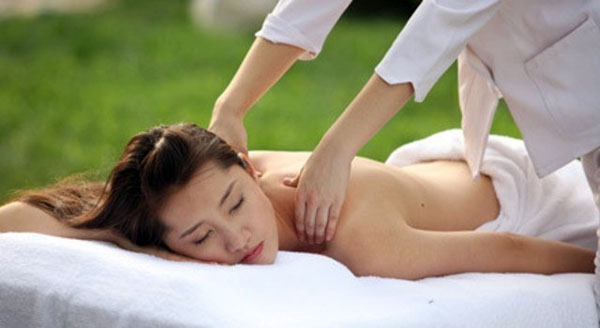The manipulations of self massage refer to the fact that the patient himself massages a certain part of the body surface with certain manipulations to strengthen the body, eliminate diseases and prolong life. Almost all parts of the body can be used for self massage except the hack due to its inconvenience.
1. Massage of the head and face
(1) Kneading-pressing Jingming (BL 1).
Press the two sides of Jingming (BL 1) respectively with the tips of the thumb and index finger for 20 times to 30 times. It is applicable to blurred vision, near-sightedness and many other diseases. Click here to learn TCM Diagnosis for Duodenitis.
(2) Kneading-pressing Yintang (EX-HN 3).
Knead and press Yintang (EX-HN 3) with the whorled surface of the thumb for 20 to 30 times. It is applicable to headache, vertigo, etc.
(3) Pushing the forehead on either side
Close up two to five fingers of both hands and place these fingers on Yintang (EX-HN 3). Push outwards along the two eyebrows respectively to reach Taiyang (EX-HN 5) for three to five times. Then, push vertically and upwards along Yintang (EX-HN 5) and gradually push outwards on either side to reach the hairline. Afterwards, push downwards gradually on either side to reach the two eyebrows. It is applicable to headache, head distension, vertigo, insomnia, etc. Click here to learn Chinese medicine Treatment for Duodenitis.
(4) Kneading-pressing Baihui (GV 20)
Knead Baihui (GV 20) forwards with the middle finger or the palmar side of the index finger from gently to forcefully step by step for 20 to 30 times. It is applicable to visceroptosis, proctoptosis, vertigo, headache, tinnitus, insomnia, etc. Click here to learn TCM Treatment Evaluation for Duodenitis.

2. Massage of upper limbs
(1) Rubbing the shoulder
Press and knead Jianyu (LI 15) forcefully with the whorled surface of one middle finger until soreness and distension occur. It is applicable to periarthritis of shoulder, rheumatalgia, and paralysis of upper limbs, etc. Learn more information, please read Erosive Gastritis in TCM.
(2) Pressing-kneading around the elbow joint
Alternately press and knead Quchi (LI 11), Shousanli (LI 10), Chize (LU 5), Quze (PC 3), etc. with the whorled surface of one thumb until local soreness and distension occur. It is applicable to bronchial asthma, dry and sore throat, pain of the elbow and arm, numbness, etc. Learn more information, please read Causes of Erosive Gastritis in TCM.
(3) Pressing-kneading Hegu (LI 4)
Press the contralateral Hegu (LI 4) with one thumb and press the corresponding site of the palm surface with the index finger from gently to forcefully for 20 to 30 times. It is applicable to headache, toothache, sore throat, ocular pain, facial paralysis, abdominalgia, diarrhea, constipation as well as pain of upper limbs, numbness, spasm of the finger, etc. Learn more information, please read Symptoms of Erosive Gastritis in TCM.
3. Massage of lower limbs
(1) Digitally pressing Huantiao (GB 30)
Digitally press the homolateral Huantiao (GB 30) with the first finger joint of the thumb or the thumb tip for 20 to 60 times. It is applicable to rheumatic arthralgia, sciatica, paralysis of lower limbs, etc. Learn more information, please read Chinese medicine Treatment for Erosive Gastritis.
(2) Pressing-kneading Zusanli (ST 36)
Press the homolateral Zusanli (ST 36) with the thumb, with the other four fingers keeping close to the back of the leg. Press and knead Zusanli (ST 36) outwards for 20 to 40 times. It is applicable to gastralgia, vomiting, abdominal distension, dysphagia, diarrhea, insomnia, dizziness, flaccidity of lower limbs, paralysis, etc. Learn more information, please read TCM Treatment Evaluation for Erosive Gastritis.
(3) Rubbing Yongquan (KI1)
Keep one minor thenar eminance close to Yongquan (KI 1) of the sole and rub the acupoint rapidly and forcefully until the site is hot. Rub the two feet alternately. The method is applicable to pain of vertex, vertigo, sore throat, aphasia, insomnia, and pain of the sole, etc. Learn more information, please read Enlarged Spleen in TCM.
4. Massage of the waist
Pressing and kneading Yaoyan(EX-BT) : Clench the fists tightly and press Yaoyan (EX-B 7) with the metacarpophalangeal articulations of the thumb to rotate, press and knead forcefully until local soreness and distension occur. It is applicable to aching pain of the waist, inflexible movement, diarrhea, etc. Learn more information, please read Causes of Enlarged Spleen in TCM.
5. Massage of the chest and abdomen
(1) Scrubbing the chest
Keep the major thenar eminance or the palm close to Zhongwan (CV 12) and scrub it forcefully. Its application is the same as the above one.
(2) Kneading Zhongwan (CV 12)
Keep the major thenar eminance or the palm close to Zhongwan (CV 12) and knead it forcefully and clockwise for about two to five minutes. It is applicable to epigastric discomfort, indigestion, abdominalgia, diarrhea, etc. Learn more information, please read Symptoms of Enlarged Spleen in TCM.







